Methodology
Agile Management methodology saves time and money.
We are believers in getting it right every time for our customers. We do that by using Agile as our management methodology. It takes years of hard work to build a winning reputation - and even more work to keep it. Successful software projects are built by people - working with the customer, using sound planning, understanding the requirements, and corresponding or meeting frequently to ensure all of us are on the same page. Developers disappearing into a dark room for months is history.
We help our clients take their ideas for mobile-accessible applications and put them online. We help them work through usability aspects, back-end services, and data-integration. Native applications offer richer capabilities and user experiences. We create native Apple iOS (iPad and iPhone) applications as well as those for Android. We would be glad to discuss your project.

It Doesn’t Have To Be This Way. Use Agile Methodology to Better Control The Process.
It doesn’t have to be this way. The Aptia team uses a light weight, proven methodology called Agile that works in any size business – small, medium or large. Agile provides our software developers and you with the tools needed to design custom software programs and software applications that easily adapt to shifting priorities and changes in focus – as so often happens in software development. Agile uses an iterative process, that, at its simplest, means a little work is done, the customer makes sure they are happy with where it is going, more work is done and so on until the project is complete.
The key to Agile is the Product Team model. This team contains all of the skill sets needed to deliver a successful software product and includes a product owner, developer, architect, quality assurance, and other members as required. In some cases, these are the same people depending on the size of the project.
You or a person designated to act on your behalf is key to the team’s success. That’s right; you are a member of the team and help us make the project successful. You help define requirements, set priority and define what makes the software acceptable - each step of the way. You work with the team to make this happen.
Principles of Agile Management
- The highest priority is to satisfy the customer through early and continuous delivery of valuable software
- Welcome changing requirements, even late in development. Agile processes harness change for the customer’s competitive advantage
- Deliver working software frequently, from a couple of weeks to a couple of months, with a preference for the shorter timescale
- Business people and developers must work together daily throughout the project
- Give individuals the environment and support they need, and trust them to get the job done
- The most efficient and effective method of conveying information to and within a development team is face-to-face conversation
- Working software is the primary measure of progress
- Promote sustainable development
- The sponsors, developers and users should be able to maintain a constant pace indefinitely
- Continuous attention to technical excellence and good design enhances agility
- Simplicity – the art of maximizing the amount of work not done – is essential
- The best architectures, requirements and designs emerge from self organizing teams
- At regular intervals, the team should reflect on how to become more effective, and then tune and adjust its behavior accordingly
Benefits
- Simplicity and transparency
- Higher customer satisfaction
- Greater staff morale and retention
- Improved quality deliverables
- Improved business value
- Quicker Return on Investment (ROI)
- Increased productivity and decreased development costs
- Ability to rapidly change direction
- Better Risk Management through Client involvement